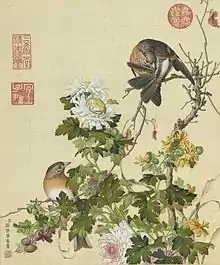| Four Gentlemen | |||||||||||||||||||||||||
|---|---|---|---|---|---|---|---|---|---|---|---|---|---|---|---|---|---|---|---|---|---|---|---|---|---|
| Chinese | 四君子 | ||||||||||||||||||||||||
| |||||||||||||||||||||||||
In Chinese art, the Four Gentlemen or Four Noble Ones (Chinese: 四君子; pinyin: Sì Jūnzǐ), is a collective term referring to four plants: the plum blossom, the orchid, the bamboo, and the chrysanthemum.[1][2] The term compares the four plants to Confucian junzi, or "gentlemen". They are commonly depicted in bird-and-flower paintings, a broad category of classical Chinese art, and they are particularly popular subjects for ink wash painting.
The Four Gentlemen are a recurring theme in art because of their long history as symbols of traditional Chinese virtues, such as uprightness, purity, humility, and perseverance despite harsh conditions. Each of them represent a different season (the plum blossom for winter, the orchid for spring, the bamboo for summer, and the chrysanthemum for autumn), the four are used to depict the unfolding of the seasons through the year.
The Four Gentlemen have been used in Chinese painting since the time of the Song dynasty (960–1279) and were later adopted elsewhere in East Asia by artists in Korea, Japan, and Vietnam.
Gallery
 Orchids and Bamboo by Zheng Xie, c. 1740
Orchids and Bamboo by Zheng Xie, c. 1740 Bamboo at Qingbige Pavilion by Ke Jiusi, c. 1338
Bamboo at Qingbige Pavilion by Ke Jiusi, c. 1338 Chrysanthemums from the Xian'e Changchun Album by Giuseppe Castiglione (1688–1766)
Chrysanthemums from the Xian'e Changchun Album by Giuseppe Castiglione (1688–1766)
See also
References
- ↑ "Orchids: The Four Gentlemen" (PDF). Archived from the original (PDF) on 2015-09-24. Retrieved 2012-05-21.
- ↑ Symbolism in Brush Painting
External links
- Paintings of the Four Gentlemen at China Online Museum